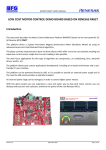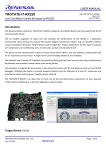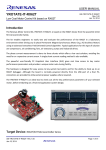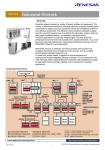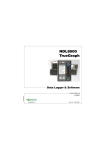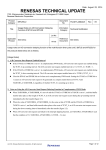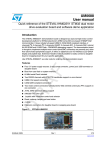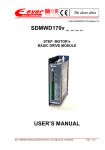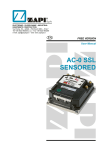Download Renesas SH7085 Product data
Transcript
APPLICATION NOTE SH7125, SH7085 MCRP05: Brushless AC Motor Control Reference Platform Introduction This document contains the description of the Motor Control Reference Platform [MCRP05] based on the powerful 32-bit RISC MCU SH7125 or SH7085. The SH family is offering unique set of peripherals to drive any motors and is featuring several protection features for industrial usage. This platform controls a sensorless 3-phase Brushless Sinusoidal Synchronous motor inverter by using advanced Field Oriented Control algorithm (FOC). The motor used is a Brushless motor called also Permanent Magnet motor (PMAC) or PMSM or BLAC. The system is in closed loop as the current detection is done via a single shunt (three shunts is optional) which offers a very low cost solution and avoid any expensive encoder or current sensor. The main focus applications are compressors, air conditioning, fans, industrial drives, washer, etc. The platform is flexible enough to develop any application using Brushless motor (synchronous & asynchronous). The main features are: 1) Sensorless [No need of tachometer or encoder sensors] 2) High Speed 3) High efficiency [Due to the vector-type motor control] 4) Low noise alignment] [Due to the high reachable switching frequency and to the optimal 5) Low Cost [Due to high integration and to reduced component count] 6) High Reliability [Due to high integration and to reduced component count] REG05B0051-0100/Rev.1.00 March 2009 Page 1 of 37 SH7125, SH7085 MCRP05: Brushless AC Motor Control Reference Platform Content MCRP05: BRUSHLESS AC MOTOR CONTROL REFERENCE PLATFORM........................................... 1 INTRODUCTION .......................................................................................................................................... 1 CONTENT .................................................................................................................................................... 2 PLATFORM OVERVIEW: HARDWARE DESCRIPTION............................................................................ 3 PLATFORM OVERVIEW: POWER STAGE DESCRIPTION ...................................................................... 4 CURRENT DETECTION METHODS: .......................................................................................................... 6 PLATFORM OVERVIEW: CPU BOARD ..................................................................................................... 7 PERMANENT MAGNET BRUSHLESS MOTOR MODEL .......................................................................... 9 SENSORLESS VECTOR CONTROL ALGORITHM USING SHUNT CURRENT DETECTION............... 15 SOFTWARE DESCRIPTION IN DETAILS ................................................................................................ 16 SPACE VECTORS TRANSFORMATIONS IN DETAILS .......................................................................... 18 PWM MODULATION TECHNIQUE ........................................................................................................... 20 FLUX PHASE ESTIMATION TECHNIQUE ............................................................................................... 21 MCRP05 – PERFORMANCE FIGURES.................................................................................................... 22 DEVELOPING USING THE MCRP05........................................................................................................ 23 MCRP05 SAFETY CONSIDERATIONS .................................................................................................... 24 ENCODER & TACHOMETER INTERFACES ........................................................................................... 25 HALL SENSORS DETECTION.................................................................................................................. 27 SINGLE SHUNT CURRENT DETECTION ................................................................................................ 28 SELECTION BETWEEN SINGLE & THREE SHUNTS............................................................................. 29 MOTOR CABLES COLOURS AND DESCRIPTION................................................................................. 31 MCRP05 – SOFTWARE TUNING USING THE “CUSTOMIZE.H” FILE .................................................. 32 PC INTERFACE – PLATFORM TUNING & MONITORING ...................................................................... 33 WEBSITE AND SUPPORT ........................................................................................................................ 36 REG05B0051-0100/Rev.1.00 March 2009 Page 2 of 37 SH7125, SH7085 MCRP05: Brushless AC Motor Control Reference Platform Platform Overview: Hardware description The MCRP05 is mainly divided into three parts: 1) CPU board 2) Power stage 3) Low voltage demo system BLAC motor The user interface is the standard user interface used for any Motor Control platform from Renesas. Furthermore, the MCRP05 can be fully controlled via a dedicated serial PC interface. The parameters may be changed via the GUI software after connection to the target. REG05B0051-0100/Rev.1.00 March 2009 Page 3 of 37 SH7125, SH7085 MCRP05: Brushless AC Motor Control Reference Platform Platform Overview: Power Stage description The Power stage is based on the Intelligent Power Module called DIP-IPM 20A/600V from Mitsubishi: PS21065. The IPM is constituted with six IGBTs and integrates the IGBT drivers & a reliable protection function: - For upperarm IGBTs: drive circuit, high voltage isolated highspeed level shifting, low voltage REG05B0051-0100/Rev.1.00 March 2009 Page 4 of 37 SH7125, SH7085 MCRP05: Brushless AC Motor Control Reference Platform detection, short circuit protection (fault signal) - For lower-arm IGBTs: drive circuit, low voltage detection, short circuit protection (fault signal) - Fault signalling: corresponding to a short circuit fault (lower-side IGBT) or low voltage fault (lower-side IGBT). Such feature is quite appreciated for debug purposes. - Input interface: 5V line CMOS/TTL compatible, Schmitt trigger circuit. The IPM is a very reliable solution, low cost with a long life and ensures short dead time for our application. The MCRP05 power stage is powered via the external 24V power supply. No rectifier for higher voltages is available on the board but any rectified voltage up to 400V can be supplied via the connector X1 of the power board. For any signals testing an isolated oscilloscope is mandatory to avoid any electrical shocks when a high voltage is supplied to the power stage. REG05B0051-0100/Rev.1.00 March 2009 Page 5 of 37 SH7125, SH7085 MCRP05: Brushless AC Motor Control Reference Platform Current detection methods: The power stage board is fully working in the following modes: 1) Three Shunts current detection 2) Single Shunt current detection 1) The three shunts configuration allow higher PWM frequency because the influence of dead time versus PWM period is not significant for the sensorless algorithm. 2) In the three shunts configuration the maximum PWM frequency is the following: a. Fclock = 80MHz Æ 1/35µs Æ FPWM max. = 28.5kHz b. Fclock = 50MHz Æ 1/56µs Æ FPWM max. = 17.8kHz 3) All the previous data are calculated supposing that all the control loops are executed each PWM period, higher frequency can be reached if control loop frequency is slower than PWM frequency. In normal industrial application 3KHz control loop frequency is normally used. The MCRP05 is offering one alternative: either 3KHz or 10KHz to offer a very high dynamics to the system. 4) The single shunt configuration forces the designer to reduce the PWM frequency. a. The PWM frequency must be reduced if the load dynamics is higher. b. On typical high voltage motors the max. reachable frequency is less than 15kHz. c. The maximum PWM frequency is reversely proportional to the needed dead-time. d. The bigger is the dead-time vs. the PWM period the bigger is the “hidden time” that causes wrong control [wrong alignment between mechanical phase and electrical phase] in case of high dynamic load. e. The MCRP05 is offering the choice between 10KHz or 20KHz. REG05B0051-0100/Rev.1.00 March 2009 Page 6 of 37 SH7125, SH7085 MCRP05: Brushless AC Motor Control Reference Platform Platform Overview: CPU Board The CPU board is available in two models: 1) SH7085 [Maximum clock frequency: 80MHz] 2) SH7125 [Maximum clock frequency: 40MHz] MCRP05 has been developed in order to demonstrate the excellent performances of SH2/SH2A cores in combination with state of the art motor control dedicated peripherals (MTU2 PWM module including dead-time insertion & compensation). Please find below the detailed features of each MCU. The main purpose of this board is to drive Brushless AC [PMAC, 180°] motors in sensorless both using single-shunt current reading technique and also using three shunts current reading technique. MCRP05 software can be modified to drive 3-phase induction motors (asynchronous motors) in sensorless mode with very high performances using FOC algorithm. REG05B0051-0100/Rev.1.00 March 2009 Page 7 of 37 SH7125, SH7085 MCRP05: Brushless AC Motor Control Reference Platform Please find below the main MCU features: SH7125 SH7085 Internal clock 50MHz 80MHz MIPS 65MIPS 110MIPS MUL timing 20ns 12.5ns DIV 1.9µs 1.2µs Saturation Arithmetic Yes Yes Flash 64k / 128k 256k RAM 8K 16K External RAM No, Single Chip Yes BSC 3 Phase PWM unit One Two PWM fault input Yes, POE Yes, POE MTU2S second PWM No Yes Input capture 19 PWM Resolution (bit @ > 15kHz) >10 A/D converter resolution 10-bit > 11 [MTU2] > 12 [MTU2S] 10-bit A/D channels 8 12 A/D conversion time 2µs 2µs A/D module number 2 x S/H modules 3 x S/H modules A/D sweep mode Yes Yes UART (asynchronous) 3 3 DTC No Yes Code security for On-Chip Flash Yes Yes Watchdog Timer Yes Yes Independent clock for WDT Yes Yes CPU Core Memory Peripherals Communication interfaces REG05B0051-0100/Rev.1.00 March 2009 Page 8 of 37 SH7125, SH7085 MCRP05: Brushless AC Motor Control Reference Platform Permanent Magnet Brushless motor model The synchronous permanent magnets motor (sinusoidal brushless motor) is widely used in the industry. More & more home appliance makers are now using such brushless motor, mainly because of the intrinsic motor efficiency. The permanent magnet motor is made with few components: 1. A stator formed by stacking sheared metal plates where internally the copper wiring is wound, constructing the stator winding 2. A rotor in which permanent magnets are fixed 3. Two covers with ball bearings that keep together the stator and the rotor; the rotor is free to rotate inside the stator “a” winding “b” winding ia Motor axis (shaft) + va vb “a” winding magnetic axis ic ib + vc How current flows into “a” winding “c” winding Stator windings schematic The working principle is quite simple: if we supply the motor with a three-phase system of sinusoidal voltages, at constant frequency, in the stator windings flows sinusoidal currents, which create a rotating magnetic field. The permanent magnets in the rotor tend to stay aligned with the rotating field, so the rotor rotates at synchronous speed. The main challenge in driving this type of motor is to know the rotor position in real-time, so mainly implementation are using a position sensor or a speed sensor. In our implementation, the system is using either one or three shunts to detect the rotor position in real-time. REG05B0051-0100/Rev.1.00 March 2009 Page 9 of 37 + SH7125, SH7085 MCRP05: Brushless AC Motor Control Reference Platform Let’s analyse the motor from a mathematic point of view. If we apply three voltages va(t), vb(t), vc(t) to the stator windings, the relations between phase voltages and currents are: dλ a dt dλ vb = RS ib + b dt dλ vc = RS ic + c dt va = RS ia + - λi is the magnetic flux linkage with the i-th stator winding - RS is the stator phase resistance (the resistance of one of the stator windings) The magnetic flux linkages λi are composed by two items, one due to the stator currents, one to the permanent magnets. The permanent magnet creates a magnetic field that is constant in amplitude and fixed in position in respect to the rotor. β axis c axis a α c’ b’ a axis c β’ Λm ϑ α axis β’ b α’ a’ b axis Real axes (a, b, c) and equivalent ones (α, β); a fixed amplitude vector can be completely determined by its position respect the (α, β) system (angle ϑ) This magnetic field can be represented by vector Λm whose position in respect to the stator is determined by the angle ϑ between the vector direction and the stator reference frame. The contribution of the permanent magnets in the flux linkages depends on the relative position of the rotor and the stator represented by the mechanical-electric angle ϑ. REG05B0051-0100/Rev.1.00 March 2009 Page 10 of 37 SH7125, SH7085 MCRP05: Brushless AC Motor Control Reference Platform It is, in every axis, the projection of the constant flux vector Λm in the direction of the axis: λa = Lia + Λ m cos(ϑ ) λb = Lib + Λ m cos(ϑ − 2π 3 ) λc = Lic + Λ m cos(ϑ − 4π 3 ) Supposing that the rotor is rotating at constant speed ω (that is: ϑ(t) = ωt) the flux linkages derivatives can be calculated, and we obtain: dia − ωΛ m sin(ϑ ) dt di vb = RS ib + L b − ωΛ m sin(ϑ − 2π ) 3 dt di vc = RS ib + L b − ωΛ m sin(ϑ − 4π ) 3 dt v a = RS i a + L A “three phases system” may be represented by an equivalent “two phases system”. So the by using specific transformations, our three equations system is equivalent to a two equations system. It is basically a mathematical representation in a new reference coordinates system. In the two phases (α,β) fixed system the above equations become: vα = RS iα + vβ = RS iβ + dλα dt dλβ dt For the magnetic field equations, we got: λα = Liα + λαm = Liα + Λ m cos(ϑ ) λβ = Liβ + λβm = Liβ + Λ m sin(ϑ ) After performing derivation: dλα di di = L α − ωΛ m sin(ϑ ) = L α − ωλβm dt dt dt diβ diβ dλβ =L + ωΛ m cos(ϑ ) = L + ωλαm dt dt dt REG05B0051-0100/Rev.1.00 March 2009 Page 11 of 37 SH7125, SH7085 MCRP05: Brushless AC Motor Control Reference Platform Finally, we obtain for the voltages in (α,β) system: diα − ωλβm dt di vβ = RS iβ + L β + ωλαm dt vα = RS iα + L A second reference frame is used to represent the equations as the frame is turning at the rotor speed. So the “d” axis is chosen in the direction of the magnetic vector Λm, and with the “q” axis orthogonal to the “d” axis. The new reference system is (d,q). The reference frame transformations from the (α,β) system to the (d,q) system depends on the instantaneous position angle ϑ So we obtain two inter-dependant equation in the (d,q) system: did − ωLiq dt diq vq = RS iq + L + ωLid + ωΛ m dt vd = RS id + L These two equations represent the mathematical motor model. A control algorithm which wants to produce determined currents in the (d, q) system must impose voltages given from the formulas above. This is ensured by closed loop PI control on both axis “d” & “q” (Proportional Integral). Since there is a mutual influence between the two axes, decoupling terms can be used. In the block scheme, the mechanic part is included, “p” is the number of pole pairs, while “B” represents friction, “J” the inertia, “τload“ the load torque and “τ” the motor torque. 3 2 τ = × p×Λ REG05B0051-0100/Rev.1.00 March 2009 Page 12 of 37 SH7125, SH7085 MCRP05: Brushless AC Motor Control Reference Platform The angular speed ω is represented in the scheme as ωe to distinguish the electrical speed from the mechanical one. Vd 1/(R+sL) + Id + Lωe Vq +1/(R+sL) Iq pL (3/2)pΛ τ +- τload 1/(B+sJ) ωmec Λωe pΛ Let’s now consider the equations we have seen in (α,β) system: vα = RS iα + vβ = RS iβ + dλα dt dλβ dt These equations show that magnetic flux can be obtained from applied voltages & measured currents simply by integration: t λα = λα 0 + ∫ (vα −RS iα )dt 0 t λβ = λβ 0 + ∫ (vβ −RS iβ )dt 0 Furthermore: Λ m cos(ϑ ) = λα − Liα Λ m sin(ϑ ) = λβ − Liβ REG05B0051-0100/Rev.1.00 March 2009 Page 13 of 37 SH7125, SH7085 MCRP05: Brushless AC Motor Control Reference Platform As the phase inductance L is normally small, we can neglect the inductance contribution in the equation. So we get: λα = Λ m cos(ϑ ) λβ = Λ m sin(ϑ ) So in the (α,β) system phase we obtain from the flux components: λ ϑ = arctan( β λ ) α The system speed ω can also be deduced from the derivative of the angle ϑ. Based on this, a sensorless control algorithm was developed to give the imposed phase voltages, to measure phase currents, to estimate the angular position ϑ and finally the system speed: ⎛d ⎞ w =⎜ ϑ⎟ ⎝ dt ⎠ REG05B0051-0100/Rev.1.00 March 2009 Page 14 of 37 The only different between the three shunts and the single shunt configurations is in the “Current Detection” block, the rest of the algorithm remains the same. Please, find below the FOC sensorless algorithm block diagram. Sensorless vector control algorithm using shunt current detection SH7125, SH7085 MCRP05: Brushless AC Motor Control Reference Platform Sensorless vector control algorithm using shunt current detection REG05B0051-0100/Rev.1.00 March 2009 Page 15 of 37 SH7125, SH7085 MCRP05: Brushless AC Motor Control Reference Platform Software Description in details On MCRP05 this software is working both on SH7125 [50MHz] and on SH7085 [80MHz], in both cases the algorithm leaves enough time for other tasks as well as free resources [peripherals, I/O pins, FLASH and RAM] for other purposes. In particular the motor control library uses the following resources: 1) Flash memory usage: < 8Kbytes 2) RAM memory usage: ~1Kbytes 3) Interrupt Service Routines timing: < 35µs [@ 80MHz] The following flow chart shows the software implementation of the motor control library. REG05B0051-0100/Rev.1.00 March 2009 Page 16 of 37 SH7125, SH7085 MCRP05: Brushless AC Motor Control Reference Platform Interrupt occours at through of pwm generation (timer4 underflow) Single-Shunt A/D conversions results reading New phase setting Normal A/D conversion (vbus etc.) start "d" axe current PI produces "d" axe voltage set "q" axe current PI produces "q" axe voltage set While waiting for A/D end, scaling of single shunt conversions Voltages anti-transformations (d, q)->(a, b)->(u, v, w) Scaling normal A/D conversions results No Modulation (u, v, w)voltages->(u, v, w)duties Motor energized? Yes Single shunt A/D conversions setting Estimators reset Current transformations (u, v, w)->(a, b)->(d,q) Flux phase extimation Speed extimation Startup? Yes No Speed PI produces Iq reference Startup procedure End of main interrupt REG05B0051-0100/Rev.1.00 March 2009 Page 17 of 37 SH7125, SH7085 MCRP05: Brushless AC Motor Control Reference Platform Space vectors transformations in details Find below the detailed equations used for the coordinates transformations. 2 1 1 (ga − gb − gc ) = ga 3 2 2 2 3 3 1 1 gβ = ( gb − gc ) = (gb − gc ) = (g a + 2gb ) 3 2 2 3 3 gα = (a, b, c) → (α, β) g a = gα 1 3 g b = − gα + g β = (− g a + 3g b ) / 2 2 2 1 3 g c = − gα − g β = (− g a − 3g b ) / 2 2 2 (α, β) → (a, b, c) g d = g α cos(ϑ ) + g β sin(ϑ ) g q = − g α sin(ϑ ) + g β cos(ϑ ) (α, β) → (d, q) gα = g d cos(ϑ ) − g q sin(ϑ ) g β = g d sin(ϑ ) + g q cos(ϑ ) (d, q) → (α, β) 2 g d = ( g a cos(ϑ ) + g b cos(ϑ − 2π / 3) + g c cos(ϑ − 4π / 3)) 3 2 g q = − ( g a sin(ϑ ) + g b sin(ϑ − 2π / 3) + g c sin(ϑ − 4π / 3)) 3 (a, b, c) → (d, q) g a = g d cos(ϑ ) − g q sin(ϑ ) g b = g d cos(ϑ − 2π / 3) − g q sin(ϑ − 2π / 3) g c = g d cos(ϑ − 4π / 3) − g q sin(ϑ − 4π / 3) potenzad ,q = potenzaα ,β = (d, q) → (a, b, c) 2 potenzaa ,b ,c 3 REG05B0051-0100/Rev.1.00 March 2009 Page 18 of 37 SH7125, SH7085 MCRP05: Brushless AC Motor Control Reference Platform u a = U cos(ωt + ϕ 0 ) ub = U cos(ωt + ϕ 0 − 2π / 3) uα = U cos(ωt + ϕ 0 ) u c = U cos(ωt + ϕ 0 − 4π / 3) ↔ u β = U sin(ωt + ϕ 0 ) REG05B0051-0100/Rev.1.00 March 2009 u d = U cos(ϕ 0 ) ↔ u q = U sin(ϕ 0 ) (ϑ=ωt) Page 19 of 37 SH7125, SH7085 MCRP05: Brushless AC Motor Control Reference Platform PWM Modulation technique VDC Figure X.X: geometrical representation of the rotating star VDC is the bus voltage. The modulation method used has a very important advantage: one of the three duty cycles is always zero. It means that the switches commutations are reduced by a factor of 30%, with a significant reduction of switching losses, so higher system efficiency. The star-centre is not at a fixed voltage value, but describes a curve composed by circle arcs. The maximum RMS output value we can obtain with this method is equal to the value that can be reached with space vector modulation and other methods. The other known methods don't allow such reduction of the power consumption at low voltage amplitude. REG05B0051-0100/Rev.1.00 March 2009 Page 20 of 37 SH7125, SH7085 MCRP05: Brushless AC Motor Control Reference Platform Flux Phase estimation technique Low pass filter xn Derivation yn yn= K x yn-1 + xn with K = d dt dn= yn - yn-4 Low pass filter dn zn zn= K x zn-1 + dn 1023 1024 REG05B0051-0100/Rev.1.00 March 2009 Page 21 of 37 SH7125, SH7085 MCRP05: Brushless AC Motor Control Reference Platform MCRP05 – Performance figures SH7085 @ 80MHz Switching Frequency: 10KHz 35% CPU usage Free resources 65% SH7085 @ 80MHz Sw itching Frequency: 16KHz 40% CPU usage Free resources 60% SH7085 @ 80MHz Sw itching Frequency: 20KHz 25% CPU usage Free resources 75% REG05B0051-0100/Rev.1.00 March 2009 Page 22 of 37 SH7125, SH7085 MCRP05: Brushless AC Motor Control Reference Platform Developing using the MCRP05 On the SH7125 MCU boards, two different connectors are visible: one if for the E8 tool and the other one for E10A. Please be very careful when connected the tool to the MCRP05. Furthermore, an isolated oscilloscope must be used if any high voltage is connected to the power stage board. E8 Reset E10A Serial U/I RS232 REG05B0051-0100/Rev.1.00 March 2009 Page 23 of 37 SH7125, SH7085 MCRP05: Brushless AC Motor Control Reference Platform MCRP05 Safety considerations MCRP05 is designed as a demonstration and development set. The case is delivered with a compact external power supply providing low voltages (5V, 15V, 23V). The DC Bus voltage is 23V to guarantee any electric shock during demonstration. The use of no other external energy sources guarantees that no electrical shocks are possible when using MCRP05 with E10A emulator or with a PC connected. Any other possible use is not supported and should be avoided. The X1 connector of the power stage is connected to the DC power Bus. It is provided only for test purposes to connect any other specific motors and any other DC bus voltage. Please be aware that the power bus reference (-VBUS) is directly connected to the MCU board ground. By using the E10A emulator, it is connected directly with the PC ground. It’s strongly recommended to use a transformer to insulate the board from the PC when it’s connected to the RS232. The RS232 interface is electrically insulated (opto-coupled) from the rest of the demo set, but for safety purposes it must be considered NOT insulated. REG05B0051-0100/Rev.1.00 March 2009 Page 24 of 37 SH7125, SH7085 MCRP05: Brushless AC Motor Control Reference Platform Encoder & tachometer interfaces For the development of the platform, an encoder and current transducers (LEM) were used. That’s why it is possible to connect any five-wires encoder to the platform and adapt the software source code to enable the function. A quadrature encoder can be used to detect the motor speed. It can be connected to the X4 connector, as indicated in the figure. The pin out is: 1) Encoder Ground 2) Encoder A 3) Encoder B 4) Encoder 0 (if the encoder uses a zero signal) 5) Encoder Positive supply (+5V) 1 X 4 C O N N . In the MCRP05 software some routines for encoder reading are already done and can be found in “motorcontrol.c” file. They are: • void McrpLib_StartEnc(void): timer 1 settings (phase counting mode 1) for encoder input reading, timer start. • void McrpLib_ReadEnc(void): encoder reading. In the same file “motorcontrol.c” can be found also some macros to define encoder type. REG05B0051-0100/Rev.1.00 March 2009 Page 25 of 37 SH7125, SH7085 MCRP05: Brushless AC Motor Control Reference Platform - The default setting is for a 4096 pulses/revolution encoder (1024 teeth). - The reading of the encoder pulses is performed by the hardware peripheral of the microcontroller. - The software routine samples the result and applies the filters and the conversions. Please refer to the microcontroller manual for further details. The hardware interface to connect a tachometer reading is also provided, using connector X2. Please have a look at the figure below: the connector X2 is a two pins connector between the connect X1 (three pins) and X4 (five pins). No software interface is actually provided. REG05B0051-0100/Rev.1.00 March 2009 Page 26 of 37 SH7125, SH7085 MCRP05: Brushless AC Motor Control Reference Platform Hall sensors detection The connector X3 and the switches S3 can be used to select the detection of hall sensors signals for BLDC motor control. The software is not provided yet. Switches S3 can also be used to select HW commutation signals from power stage, for dead time compensation. Please refer to the hardware drawings for more details. The S3 DIP-switch is used to select between thee options: a fully sensorless option (by default), a sensorless using back-EMF approach where the back-EMF signals are connected to the MCU and finally the Hall sensors approach connected directly to the MCU. ON Fully sensorless Default configuration X 3 C ON N. S3 S W IT C H E S ON Sensorless Back-EMF signals enable OFF 1 2 3 4 5 6 7 8 S3 Switch CPU board Hall sensors inputs enable REG05B0051-0100/Rev.1.00 OFF 1 2 3 4 5 6 7 8 S3 Switch CPU board March 2009 ON OFF 1 2 3 4 5 6 7 8 S3 Switch CPU board Page 27 of 37 SH7125, SH7085 MCRP05: Brushless AC Motor Control Reference Platform Single Shunt Current Detection Single Shunt Current Detection REG05B0051-0100/Rev.1.00 March 2009 Page 28 of 37 SH7125, SH7085 MCRP05: Brushless AC Motor Control Reference Platform Selection between Single & three shunts In order to change between single shunts to three shunts, there are two operations to make: 1) On the back side of the power stage, two soldering points are use to enable of disable the three shunts or single shunt current detection (see below the figure) 2) On the software side in the “customize.h” file, please enable of disable the following switches: //#define SINGLESHUNT #define THREESHUNTS Only one of the “define” should remain commented Back side of the power stage board Three shunts configuration X Y Z [ Sold Z& [ Leave open X & Y REG05B0051-0100/Rev.1.00 March 2009 Single shunt configuration X Y Z [ Sold X & Y Leave open Z& [ Page 29 of 37 SH7125, SH7085 MCRP05: Brushless AC Motor Control Reference Platform PWM switching frequency and timings The PWM switching frequency can be adjusted by the user using the macro PWM_FRE in the file called “customize.h” to fulfil the application requirements. Two possible frequencies are selectable: 1) 10kHz: higher noise but higher efficiency 2) 20kHz: less noise & better sin wave shape The algorithm sampling period is fixed to 100µs (10KHz) and the main interrupt is related with the PWM frequency. Thanks to the interrupt skipping facility of the MTU2 peripheral, it becomes easy to adjust the application software to 10KHz or 20KHz. Other PWM switching frequency values can be obtained by directly modifying the macro called SEMIPER (half PWM period in MTU2 clock cycles units), but it is not recommended as the overall algorithm behaviour is affected. The timing of the main program is regulated by the macro NUM_INT in “motorcontrol.c” file. The value of NUM_INT regulates the number of interrupts in the main loop. Such macro can be adjusted but it will affect all the timings of the routines called in main program. REG05B0051-0100/Rev.1.00 March 2009 Page 30 of 37 SH7125, SH7085 MCRP05: Brushless AC Motor Control Reference Platform Motor cables colours and description • U Phase (power) WHITE/RED • V Phase (power) WHITE /YELLOW • W Phase (power) WHITE /BLACK 0 • Hall A (U) A (U) • B (V) WHITE (gives the sign of V-W back-EMF) • Hall C (W) 120 180 240 300 360 GREEN (gives the sign of U-V back-EMF) Hall B (V) 60 BLUE C (W) U-V (gives the sign of W-U back-EMF) • Hall GND BLACK • Hall +VCC RED V-W W-U REG05B0051-0100/Rev.1.00 March 2009 Page 31 of 37 SH7125, SH7085 MCRP05: Brushless AC Motor Control Reference Platform MCRP05 – Software tuning using the “customize.h” file The “customize-h” file is a very useful and flexible way to adapt the software without entering into the code itself. By commenting or modifying some lines, the complete system can be adapted to the user needs and is perfect for any platform evaluation. Select one shunt or three shunts for current detection #define SINGLESHUNT //#define THREESHUNTS #define PWM_FREQ_CUSTOM 20000 PWM frequency modulation: between 3KHz and 20KHz Selects sign of the current read through the shunt and the related amplifier stage. When using the MCRP05 schematics this line must be left as it is. When the positive input of the OpAmp is connected to GND this line must be commented. Enable the use of the external E²PROM Enable display usage Enable SCIO for external connection Control loop time in Hz between 2500Hz up to 10KHz Startup ramp time in ms min speed in RPM max speed in RPM acceleration ramp in RPM/sec polar pairs number flux current max torque current in Arms/10 stator phase resistance in Ω/10 K prop. current control K integ. current control K prop. speed control K integ. speed control #define POSCURR #define EEPROM_USED #define DISPLAY_USED #define MCRP05_SCI0_CONNECTION #define SAMPLE_FREQ_CUSTOM 10000 #define STARTUP_RAMPTIME_CUSTOM 800 #define #define #define #define #define #define #define #define #define #define #define #define RPM_MIN_CUSTOM RPM_MAX_CUSTOM R_ACC_CUSTOM C_POLI_CUSTOM ID_NOM_CUSTOM IQ_NOM_CUSTOM R_STA_CUSTOM KP_CUR_CUSTOM KI_CUR_CUSTOM KP_VEL_CUSTOM KI_VEL_CUSTOM DEADTIM_CUSTOM 600 4500 1000 2 0 30 7 150 100 30 20 2.0 #define RSHUNT_CUSTOM #define RSGAIN_CUSTOM #define AVCC_CUSTOM 100.0 5000.0 5000.0 #define RVBUS1_CUSTOM #define RVBUS2_CUSTOM 400000.0 4700.0 #define VIGBTV_CUSTOM #define VDIODOV_CUSTOM 800.0 1400.0 #define #define #define #define #define #define FIRST_FLUX_LOWPASS_TIME_CUSTOM 10 DERIVATIVE_TIME_CUSTOM 1 LAST_FLUX_LOWPASS_TIME_CUSTOM 10 FIRST_SPEED_LOWPASS_TIME_CUSTOM 5 SECOND_SPEED_LOWPASS_TIME_CUSTOM 4 THIRD_SPEED_LOWPASS_TIME_CUSTOM 3 REG05B0051-0100/Rev.1.00 Dead-time value in µs @40MHz Shunt value in mΩ Circuit gain x1000 A/D Range in mV Split resistor 1 in Ω Split resistor 2 in Ω VCESAT of the IGBT in mV Free-wheel diode forward voltage in mV Flux phase estimation is made through following steps: 1) first low pass filter, 2) derivative, 3) last low pass filter Filters parameters March 2009 Page 32 of 37 SH7125, SH7085 MCRP05: Brushless AC Motor Control Reference Platform PC Interface – Platform tuning & monitoring A complete PC based interface is available to display the main values & measurements like the motor speed, the motor currents, the torque, the DC Bus voltage, etc. Please find below the screen shot of the PC interface connected via RS232 link to the MCRP05. By selection the label on the right hand side, the graph will automatically display the realtime values, so it becomes easy to analyse the influence of the motor load on the motor speed. The range of the graph can be easily modified by clicking the button “Range”: As soon as reference speed is set, whatever the torque required the system will keep a very accurate speed showing a fast reaction time and good system dynamics. REG05B0051-0100/Rev.1.00 March 2009 Page 33 of 37 SH7125, SH7085 MCRP05: Brushless AC Motor Control Reference Platform Furthermore, the software running on the platform is using system parameters that may be modified via the PC user interface. In the main menu, it is possible to display the platform parameters & modify them. Please find above the default values for each parameter. Note that that some coefficients with “0” as values are not used like “the speed loop KD”. The stator resistance is a key parameter that needs to be adapted to each motor type. After changing the value, please click on “Apply” and perform a board reset to start the system with the new parameters. If any issues are happening during the programming of the board or during the parameters modification, a simple way is to write the magic value “33” in the first line: “Default Parameters Setting”. REG05B0051-0100/Rev.1.00 March 2009 Page 34 of 37 SH7125, SH7085 MCRP05: Brushless AC Motor Control Reference Platform Please find below the screen shot with the details. REG05B0051-0100/Rev.1.00 March 2009 Page 35 of 37 SH7125, SH7085 MCRP05: Brushless AC Motor Control Reference Platform Website and Support Renesas Technology Website http://www.renesas.com/ Inquiries http://www.renesas.com/inquiry [email protected] All trademarks and registered trademarks are the property of their respective owners. REG05B0051-0100/Rev.1.00 March 2009 Page 36 of 37 SH7125, SH7085 MCRP05: Brushless AC Motor Control Reference Platform Notes regarding these materials 1. 2. 3. 4. 5. 6. 7. 8. 9. 10. 11. 12. 13. This document is provided for reference purposes only so that Renesas customers may select the appropriate Renesas products for their use. Renesas neither makes warranties or representations with respect to the accuracy or completeness of the information contained in this document nor grants any license to any intellectual property rights or any other rights of Renesas or any third party with respect to the information in this document. Renesas shall have no liability for damages or infringement of any intellectual property or other rights arising out of the use of any information in this document, including, but not limited to, product data, diagrams, charts, programs, algorithms, and application circuit examples. You should not use the products or the technology described in this document for the purpose of military applications such as the development of weapons of mass destruction or for the purpose of any other military use. When exporting the products or technology described herein, you should follow the applicable export control laws and regulations, and procedures required by such laws and regulations. All information included in this document such as product data, diagrams, charts, programs, algorithms, and application circuit examples, is current as of the date this document is issued. Such information, however, is subject to change without any prior notice. Before purchasing or using any Renesas products listed in this document, please confirm the latest product information with a Renesas sales office. Also, please pay regular and careful attention to additional and different information to be disclosed by Renesas such as that disclosed through our website. (http://www.renesas.com) Renesas has used reasonable care in compiling the information included in this document, but Renesas assumes no liability whatsoever for any damages incurred as a result of errors or omissions in the information included in this document. When using or otherwise relying on the information in this document, you should evaluate the information in light of the total system before deciding about the applicability of such information to the intended application. Renesas makes no representations, warranties or guaranties regarding the suitability of its products for any particular application and specifically disclaims any liability arising out of the application and use of the information in this document or Renesas products. With the exception of products specified by Renesas as suitable for automobile applications, Renesas products are not designed, manufactured or tested for applications or otherwise in systems the failure or malfunction of which may cause a direct threat to human life or create a risk of human injury or which require especially high quality and reliability such as safety systems, or equipment or systems for transportation and traffic, healthcare, combustion control, aerospace and aeronautics, nuclear power, or undersea communication transmission. If you are considering the use of our products for such purposes, please contact a Renesas sales office beforehand. Renesas shall have no liability for damages arising out of the uses set forth above. Notwithstanding the preceding paragraph, you should not use Renesas products for the purposes listed below: (1) artificial life support devices or systems (2) surgical implantations (3) healthcare intervention (e.g., excision, administration of medication, etc.) (4) any other purposes that pose a direct threat to human life Renesas shall have no liability for damages arising out of the uses set forth in the above and purchasers who elect to use Renesas products in any of the foregoing applications shall indemnify and hold harmless Renesas Technology Corp., its affiliated companies and their officers, directors, and employees against any and all damages arising out of such applications. You should use the products described herein within the range specified by Renesas, especially with respect to the maximum rating, operating supply voltage range, movement power voltage range, heat radiation characteristics, installation and other product characteristics. Renesas shall have no liability for malfunctions or damages arising out of the use of Renesas products beyond such specified ranges. Although Renesas endeavors to improve the quality and reliability of its products, IC products have specific characteristics such as the occurrence of failure at a certain rate and malfunctions under certain use conditions. Please be sure to implement safety measures to guard against the possibility of physical injury, and injury or damage caused by fire in the event of the failure of a Renesas product, such as safety design for hardware and software including but not limited to redundancy, fire control and malfunction prevention, appropriate treatment for aging degradation or any other applicable measures. Among others, since the evaluation of microcomputer software alone is very difficult, please evaluate the safety of the final products or system manufactured by you. In case Renesas products listed in this document are detached from the products to which the Renesas products are attached or affixed, the risk of accident such as swallowing by infants and small children is very high. You should implement safety measures so that Renesas products may not be easily detached from your products. Renesas shall have no liability for damages arising out of such detachment. This document may not be reproduced or duplicated, in any form, in whole or in part, without prior written approval from Renesas. Please contact a Renesas sales office if you have any questions regarding the information contained in this document, Renesas semiconductor products, or if you have any other inquiries. © 2009. Renesas Technology Corp., All rights reserved. REG05B0051-0100/Rev.1.00 March 2009 Page 37 of 37





































